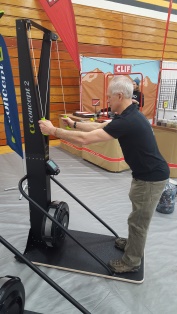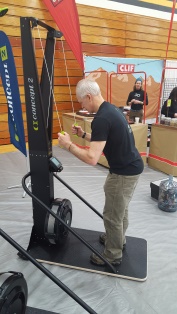SkiErg Technique: Part Two
This is the second in a three-part series of cues to help you with SkiErg technique. After having introduced hundreds of athletes to the SkiErg, I’ve noticed three very common faults that appear in new adopters. I’ve developed these memorable cues to help them work through those technique flaws. Furthermore, these are the same cues that I use to take an experienced athlete to a higher level of performance. By learning and understanding these cues, you will hopefully gain a better grasp on the mechanics and flow used in good SkiErg technique.
Part Two: Climb the Rope
Many years ago, I used to teach novice students from suburban and urban areas how to Nordic ski up in Northern Wisconsin and we had a great progression to get those exuberant young kids up and sliding in minimal time. Part of that progression entailed teaching the double pole technique, and, despite my earlier article on "Crunch, Don't Bow", we did indeed use the "bow" cue to get those kids moving with just their poles (the mind of a 6th grader is often tougher to penetrate than adult skiers actively seeking to improve their efficiency). At the time, we were plenty happy if we got a decent bend at the waist and moderate propulsion, regardless of actual ergonomics. But, in retrospect, we were not doing a great job of really maximizing the laws of physics to their advantage.
So let's talk about some of the physics involved in the process of a solid double-pole technique, which is germane to any discussion about effective SkiErg technique. In particular, we can look at the concept of lever length, focusing on your arms as the primary levers in the process of generating strong downward force with your poles. Your arms are levers that are attached to your trunk where much of the energy is generated during the poling stroke. These levers are also attached to the handles of the pole where the important forces are being applied to the snow through the shaft of the pole, or to the SkiErg monitor though the cord. The longer the lever, the more any movement at the trunk and at the shoulder will be translated into movement of the handles. With this in mind, we often see novice users of the SkiErg (and my 6th graders) extend their arms to maximum length while poling, which you might think is a good idea.

Poor Arm Position--too straight!
However, the problem with long levers is that while they can create a lot of speed at their ends, the longer they are, the less "leverage" your body has in moving them. And this is where the "Climb the Rope" cue can be a helpful reminder to attain a better arm position while using the SkiErg. I ask my athletes to imagine that they have a rope to climb, and to think about where they would hold that rope in relation to their body. With this comparison in mind, they can clearly imagine the difficulty in holding that rope at arm’s length and pulling their body weight up, recognizing that by shortening their lever length, they can improve their leverage.
At this point, I often see an over-exaggeration with their correction and they shorten up their levers too much, effectively eliminating the mechanical advantage of the arms altogether; so, athletes should play around with some different amounts of shoulder and elbow angle to help them home in where their most powerful position actually lies. During this time, I also have them play around with some small adjustments in their foot position in relation to the base of the machine, as changes in lever length can also require slight changes in the athlete’s base of support.

Good Arm Position--"climbing the rope"
Ideally, we could define exactly what the optimal angle of the shoulder and elbow would be to create the most forceful double poling motion, but this is going to be dependent on many things such as bone length or core strength. This is what makes the SkiErg the perfect tool to tinker with some of those body geometries: it allows you to determine exactly where YOU are most powerful. You have a real-time data source staring at you in that Performance Monitor and with a little time and attention to that information (using 500m split time or wattage), you should be able to find a stronger position from which to pole. What we can say for sure is that a straight arm is not optimal, no arm (hands touching shoulders) is not optimal, and your solution is going lie somewhere in between.
